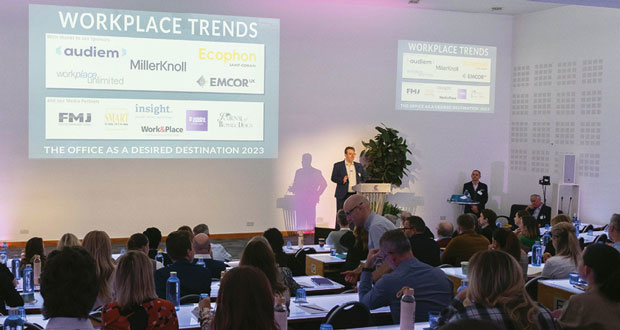Change was the overriding theme of the Workplace Trends 2023 conference, but rather than the tired old troupe on the changes to the office since the pandemic, we heard why workplace leaders need a complete change of mind set to prepare for the future
In his opening session, Chris Kane, who’s been at the forefront of Corporate Real Estate for over 30 years said that “none of us had a clear picture of where the workplace is and where it is heading. Are we even asking the right questions?” He believes all the discussions regarding the “return to the office” is a giant red herring when we’re in the middle of a transition to the digital world.
We’re in the third decade of the 21st century he explained, but trying to apply 20th century thinking and 20th century models. The big challenge is whether we have the courage to experiment, to try new things and look beyond our silos.
“Change is going to happen whether we like it or not” said Jennifer Bryan – author of ‘Leading People in Change: A Practical Guide,’. “The last few years has only accelerated that process; where once we had an idea of what was coming down the road, now we only can see a little bit down the line, and we can’t predict what is around the corner. When it comes to making a change, instead of approaching projects using hindsight we need to use foresight,” she advised.
WHY THE WORKPLACE?
Environmental Psychologist and Workplace Strategist Nigel Oseland presented the results of his research with Professor Gary Raw in partnership with MillerKnoll and Workplace Trends to gauge the appeal of working in the office compared to working from home. The main reason he revealed, why 55 per cent of respondents prefer home working compared to 37 per cent in the office is the ability to concentrate better. This suggests he said that to attract people back to the office we need to offer as high quality a space for focused work as that of the spaces for collaboration.
More disquieting for FMs were respondents’ levels of dissatisfaction with office ‘hygiene factors’ such as temperature, noise and lighting, and the fact that people with allocated desks are more likely to want to return to the office than those with unassigned desks. This challenges the entire concept of flexible workplaces. Intriguingly, while the research showed no particular preferences by the different generations, the study suggests; employers are going to have to figure out how to make the office as appealing to introverts as it is to extroverts.
If personality preferences are one of the primary reasons why home working remains so popular, an all too often overlooked set of individuals are the neurodiverse, who, explained Josh Artus, of neuroscience specialists Centric Lab account for approximately 15 per cent of the UK population. This is why the Centric Lab’s 2022 research paper for the British Council for Offices entitled ‘Designing for Neurodiversity’, was such a step forward. However, Artus cautioned, while design is important, the culture of an organisation plays an essential role in supporting these workers.
Tree Hall of Charity IT Leaders, who was diagnosed with autism at 47 echoed this sentiment. She described how dealing with the social norms of the neuro typical focused workplace can cause tremendous levels of stress for the neurodiverse and her personal insights on negotiating the workplace as an autistic person challenges our perception that organisations are doing enough to support all forms of diversity.
FOSTERING COMMUNITIES
Sharing their experiences of reshaping the relationship civil servants have with their place of work, Sara Edwards, Ruth Smethurst and Leah Jones of the Government Property Agency described how they’ve created open, sharing collaborative buildings and spaces to help occupants feel comfortable and confident.
Espousing the development of workplace communities within work spaces, Jones said: “We’re trying to get people into the office and to encourage people back they need to feel like a second home – so to help achieve that communities really are vital.”
What happens though when you unveil a sparkling new workplace but occupants complain there aren’t enough desks? This was the dilemma Diego Henrique, Head of Real Estate at Anglo American De Beers and Emily Fiddes Senior Workplace Consultant at MCM candidly shared in their session.
As they concluded: “We realised from our workshops that everyone has been on their own change journey, and people who’d spent time working at home were used to their own space and controlling their own environment.”
Making wider environmental changes is perhaps the overriding concern within the built environment said Ann Beavis of Crown Workplace who explored the challenges of ensuring that any workplace change supports organisations in their carbon reduction journey.
She remarked: “I’ve seen a lot of organisations with lots of fancy pages on their website showing their sustainable credentials. However, the actual work environment is the physical embodiment of an organisation’s brand and values, yet how many reflect those values in their workplace?
“This is why, when we’re visualising our idea of the workplace of the future this agenda should remain front and centre of our thinking.”
As Kane suggested at the beginning of the day, we need to stop looking at the workplace in isolation but go beyond the office building to ask, where, why and who it’s there to benefit?





